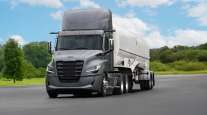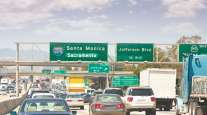Alternative Fuels Will Grow, but Diesel Remains Go-To, Daimler Exec. Says

INDIANAPOLIS — Alternative fuels and green technologies will continue to evolve and secure their roles within the trucking sector, but diesel is still the most efficient and cost-effective fuel and will be for some time to come, Kary Schaefer, general manager of marketing and strategy for Daimler Trucks North America, told attendees at the Green Truck Summit here last week.
There are opportunities for fleets to gain efficiencies by incorporating “green” fuel technologies into their operations, whether natural gas, battery-electric vehicles or others. But because each alternative to diesel brings with it issues that affect its business case, diesel will continue to be the go-to fuel for the foreseeable future, Schaefer said.
At the same time, advancements in technologies such as active safety systems and connectivity may also be considered green in that they can help reduce the environmental impact of operations, improving safety and a fleet’s sustainability
“Green means much more than tailpipe emissions,” Schaefer said. “It means running an efficient business. It means that you can run a sustainable business infrastructure, that you can drive cost and waste out and sustainability in,” she said.
Schaefer was the keynote speaker at the Green Truck Summit, produced by the National Truck Equipment Association in conjunction with its annual Work Truck Show.

Schaefer (NTEA)
Schaefer noted that two of the most talked-about alternatives to diesel — battery-electric and natural gas — have a place in some fleet operations, but their inherent limitations require that fleets must examine many issues.
For example, when exploring battery-electric vehicles fleets should consider four factors, she said: range, weight, cost and charging.
The vehicle’s range can be affected by variations due to temperature, loads and speed. Additionally, the weight of the vehicle affects the range needed. Greater range requires more batteries, and “battery packs are heavy and affect what you can carry,” she said.
While Schaefer expects battery costs to continue to drop in the short term, they are still relatively costly. She also noted that if the demand goes up, so will costs since production is limited. Fleets also must factor in the useful life of the batteries and residual value scenarios. “That hasn’t been figured out, yet,” she said.
A fleet’s operating area also affects the business case for electric vehicles since electricity costs vary across the country and can change dramatically, even hourly. Some fleets may eventually have to make a significant investment in a charging infrastructure, she said.
Schaefer said that Daimler is developing electric cars and trucks, including the Mitsubishi Fuso electric eCanter and Class 8 units, which are being tested in Europe. Much of this technology will make its way to North America, she said, although she did not specify timing.

Fuso electric eCanter (Mark Kauzlarich/Bloomberg News)
While natural gas is readily available and is an especially viable option in areas of the country with near-zero emissions regulations, the cost of natural gas vehicles and the necessary infrastructure are still the biggest hurdles for fleets.
In the end, the relative high energy density of diesel compared with alternatives means diesel will continue to be the trucking industry’s workhorse.
“For the different fuel technologies, each has its place in the market. But these will have to be combined with diesel for a very long time to come. It’s here to stay and part of fleet operations for a long time,” she said.
Meanwhile, technological advances in onboard systems and connectivity provide a gateway to green innovation for fleets, Schaefer said.
Active safety systems such as collision mitigation technology are used to help reduce the number and cost of accidents by sending warnings and applying braking on stationary and moving objects. Future onboard systems will expand to recognize other objects, such as pedestrians. Lane departure warning systems will protect the vehicle from shifting lanes, nudging it back into the lane to keep it centered.
“All of these will increase uptime and provide asset utilization. They provide a business case to make your operation more profitable,” she said.
Schaefer added that in the future vocational operations would rely more on connectivity — communication connections among the truck, the driver and back office operations — to improve efficiencies.
“Connectivity is mainly a means to an end. There are a lot of possibilities for fleets . . . being able to take vehicle data and route information and feed it into the back office and adjust how equipment is operated to get the best use possible,” she said.




